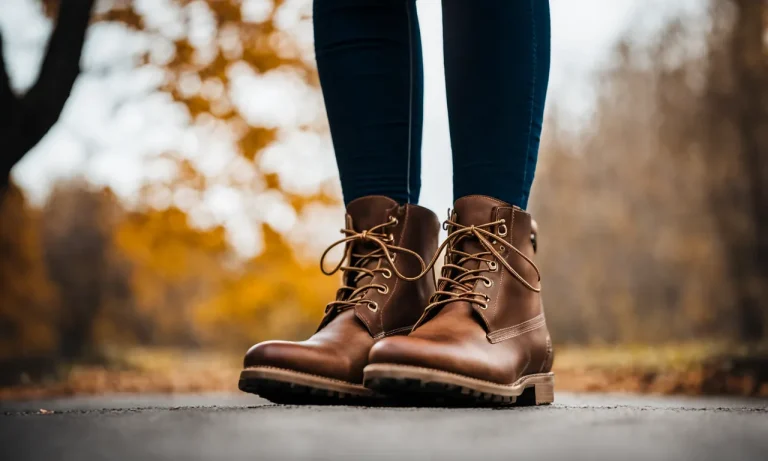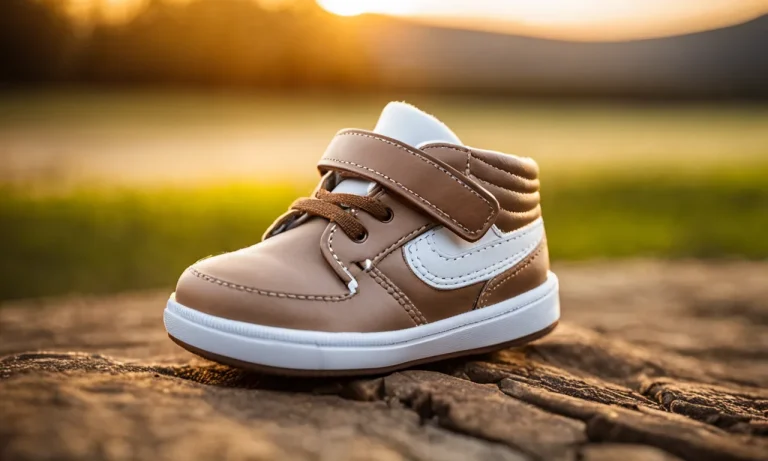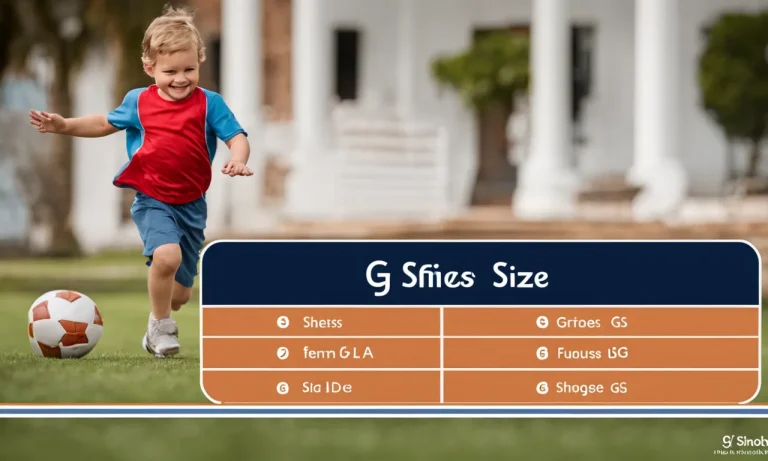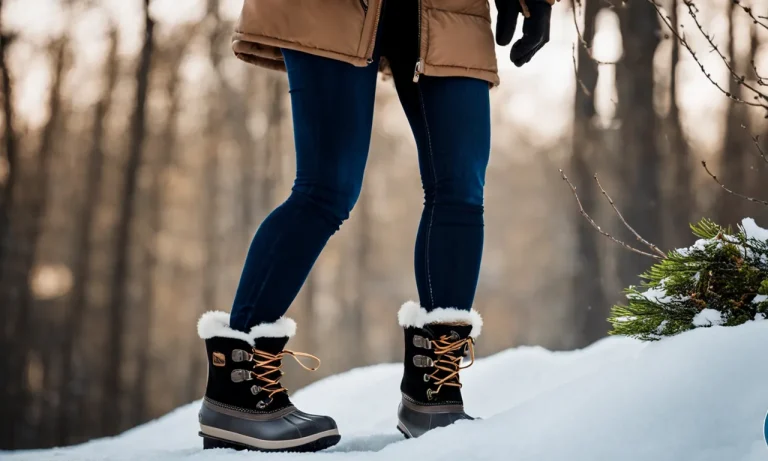Are your shoes starting to feel a bit snug? Do you have to wiggle your toes to get them to fit comfortably? If you’re short on time, here’s a quick answer to your question: You should have about a thumb’s width of space between your toes and the end of the shoe.
This gives your feet enough room to spread out when walking without your toes jamming into the front of the shoe.
In this comprehensive guide, we’ll cover everything you need to know about getting the right shoe fit. We’ll discuss what happens when shoes are too tight or too loose, how factors like sock thickness and time of day change your fit needs, style-specific sizing tips, and much more.
Why Shoe Fit Matters
Choosing the right shoe size is crucial for the overall health and well-being of your feet. A proper shoe fit not only ensures comfort but also prevents a range of foot problems that can arise from wearing ill-fitting shoes.
Prevents foot problems
Wearing shoes that are too tight or too loose can lead to various foot problems such as bunions, corns, calluses, and ingrown toenails. When shoes are too tight, they can squeeze your toes together, causing friction and pressure points.
On the other hand, shoes that are too loose can cause your feet to slide around, leading to blisters and irritation. By ensuring a proper shoe fit, you can significantly reduce the risk of developing these uncomfortable and painful foot conditions.
Allows natural foot motion
Having enough room in your shoes allows your feet to move naturally. Each step you take involves complex movements of your feet, including flexing, bending, and spreading. Shoes that are too narrow or too tight can restrict these movements, leading to discomfort and even affecting your gait.
By choosing shoes that provide adequate room for your feet, you allow them to move freely, promoting better balance and reducing the risk of foot and ankle injuries.
Improves comfort
One of the most immediate benefits of a proper shoe fit is improved comfort. When your shoes fit well, you can walk, run, or stand for longer periods without experiencing discomfort or pain. A comfortable shoe fit can enhance your overall walking experience, making daily activities more enjoyable.
It’s important to remember that comfort should be a priority when selecting shoes, as it directly impacts your physical well-being.
Remember, everyone’s feet are unique, and shoe sizes can vary between brands and styles. It’s always recommended to have your feet measured by a professional shoe fitter to ensure the best fit. Additionally, trying on shoes and walking around in them for a few minutes can give you a better idea of how they feel on your feet.
Taking the time to find the right shoe fit is well worth the effort, as it can prevent foot problems, promote natural foot motion, and greatly enhance overall comfort.
Measuring Your Feet
One of the most important steps in finding the perfect shoe fit is accurately measuring your feet. Here are a few methods you can use to measure your feet at home:
Trace your foot on paper
One simple and effective way to measure your feet is by tracing them on a piece of paper. Here’s how to do it:
- Place a blank piece of paper on a hard surface.
- Stand on the paper with your heel against a wall.
- Using a pen or pencil, trace the outline of your foot.
- Measure the length from the heel to the longest toe.
- Repeat the process for the other foot.
This method can give you a general idea of your foot size, but keep in mind that it may not be as accurate as professional measurements.
Get professionally fitted
For a more accurate measurement, consider getting professionally fitted at a shoe store. Trained professionals can measure your feet using specialized tools and provide recommendations based on your specific foot shape and size.
Getting professionally fitted is especially important if you have certain foot conditions or require specialized footwear. It can help ensure that you find shoes that provide the right amount of support and comfort for your feet.
Use a Brannock Device sizer
A Brannock Device is a commonly used tool for measuring feet. It consists of a metal platform with sliding bars and a foot-shaped measuring device. Here’s how to use it:
- Place your foot on the metal platform with your heel against the back.
- Slide the bars to align with the widest part of your foot.
- Read the measurements indicated on the device.
The Brannock Device provides precise measurements for both length and width, making it an excellent tool for finding the perfect shoe fit.
Remember, accurate measurements are crucial for finding shoes that fit well and provide the necessary support and comfort for your feet. So, don’t skip this step when shopping for new shoes!
Factors That Impact Shoe Size
Sock thickness
One important factor to consider when determining the right shoe size is the thickness of the socks you plan to wear. Thicker socks can take up more space inside the shoe, so it’s essential to try on shoes with the type of socks you typically wear.
This will ensure a proper fit and prevent discomfort or blisters caused by tightness.
Time of day
Believe it or not, your shoe size can vary throughout the day. In the morning, your feet are typically at their smallest due to the lack of swelling or fatigue. As the day progresses, your feet may expand, especially if you’ve been on your feet for extended periods.
Therefore, it’s recommended to try on shoes in the late afternoon or evening when your feet are at their largest.
Foot swelling
Foot swelling can occur due to various factors such as heat, physical activity, or certain medical conditions. If you tend to experience swelling, it’s crucial to account for this when choosing the right shoe size.
Opt for shoes that have some extra room to accommodate any potential swelling and prevent discomfort or constriction.
Prior injuries
If you have had previous foot injuries or conditions such as bunions or hammertoes, it’s essential to consider these factors when deciding on the appropriate shoe size. Certain foot issues may require extra width or depth in the shoe to provide the necessary comfort and support.
Consulting with a podiatrist can be beneficial in determining the right shoe size for your specific needs.
Foot shape
Every individual has a unique foot shape, and this can greatly impact the way shoes fit. Some people have wider feet, while others have narrower feet. Some have high arches, while others have flat feet.
It’s important to take into account your foot shape when choosing shoes, as different brands and styles may suit certain foot shapes better than others. Trying on different shoes and consulting with shoe fitting experts can help you find the perfect fit for your foot shape.
Remember, finding the right shoe size is crucial for overall foot health and comfort. Taking into consideration factors such as sock thickness, time of day, foot swelling, prior injuries, and foot shape will help ensure a proper fit and prevent any potential foot problems in the future.
Fit Tips by Shoe Style
Sneakers
When it comes to sneakers, finding the right fit is crucial for comfort and performance. You should have about a thumb’s width of space between your longest toe and the front of the shoe. This allows for natural movement and prevents your toes from being cramped.
Additionally, make sure the sneakers provide adequate support and cushioning for your feet. Visit Runners World for more information on selecting the right sneakers for your needs.
Boots
Boots come in a variety of styles, from ankle boots to knee-high boots. The fit can vary depending on the style and material of the boot. Generally, you should have enough room to wiggle your toes comfortably, but not so much room that your foot is sliding around inside the boot.
It’s also important to consider the width of your foot and choose a boot that provides enough space for your feet to breathe. For more tips on finding the perfect fit for boots, check out Shoe Carnival.
High Heels
High heels can be stylish and elegant, but they can also be uncomfortable if they don’t fit properly. It’s essential to find a pair of high heels that provides a secure fit and doesn’t pinch or squeeze your toes. Look for heels with adjustable straps or buckles that allow you to customize the fit.
Pay attention to the width of the shoe as well, as narrow-fitting heels can cause discomfort. For more tips on wearing high heels comfortably, visit Foot.com.
Flats
Flats are a versatile and comfortable option for everyday wear. When trying on flats, make sure they don’t feel too tight or too loose. Your foot should feel secure and supported, with enough room for your toes to move freely. Look for flats with cushioned insoles for added comfort.
Pro tip: if you’re in between sizes, go for the larger size to avoid any discomfort. Learn more about finding the perfect fit for flats at Zappos.
Sandals
Sandals are a great choice for warm weather, but it’s important to find a pair that fits well to avoid blisters and discomfort. Look for sandals with adjustable straps that allow you to customize the fit according to your foot shape.
Your toes should have some wiggle room, and the sandals should provide adequate support for your arches. Check out REI for tips on finding the right fit for sandals.
Signs of Good vs. Bad Fit
Good fit indicators
When it comes to shoes, a good fit is crucial for both comfort and foot health. Here are some signs to look out for to ensure that you have a good fit:
- Proper length: Your toes should have enough room to wiggle comfortably without feeling cramped. Aim for about a thumb’s width of space between the tip of your longest toe and the end of the shoe.
- Secure heel: Your heel should fit snugly in the shoe without slipping or rubbing against the back. A secure heel prevents blisters and provides stability.
- Arch support: The shoe should provide adequate support for your arch, preventing excessive pronation or supination.
- Comfortable width: Your foot should not feel squeezed or overly tight in the shoe. A comfortable width allows for natural movement and prevents discomfort or pain.
- No pressure points: A good fit means that there are no areas in the shoe that cause discomfort or pressure on your feet. Make sure there are no tight spots or rubbing against your skin.
Remember, everyone’s feet are unique, so what works for one person may not work for another. It’s important to try on different shoe styles and brands to find the best fit for your feet.
Bad fit warning signs
Wearing ill-fitting shoes can lead to various foot problems and discomfort. Here are some warning signs that indicate a bad fit:
- Toes crammed: If your toes feel cramped and compressed in the shoe, it can lead to issues like bunions, hammertoes, or ingrown toenails.
- Slipping heel: If your heel slips out of the shoe while walking, it can cause blisters and instability.
- Painful arches: Insufficient arch support can lead to discomfort and pain in the arches, as well as conditions like plantar fasciitis.
- Pinched width: Shoes that are too narrow can squeeze your feet, leading to blisters, calluses, and bunions.
- Rubbing or pressure: If you feel any rubbing or pressure points in the shoe, it can result in blisters, corns, or calluses.
If you experience any of these warning signs, it’s essential to find a better-fitting shoe to prevent further foot problems. Remember to consult with a podiatrist if you have persistent foot pain or discomfort.
For more information on finding the right shoe fit, you can visit www.apma.org/fitguide for the American Podiatric Medical Association’s shoe fit guide.
How to Break in New Shoes
Breaking in new shoes can be a painful process, but it doesn’t have to be. By following a few simple steps, you can make your new shoes more comfortable and reduce the risk of blisters and sore feet. Here are some effective methods to break in new shoes:
1. Wear around the house
One of the easiest ways to break in new shoes is to wear them around the house for short periods of time. This allows your feet to get used to the shape and feel of the shoes without putting too much stress on them.
Start by wearing them for a few hours each day and gradually increase the time as your feet adjust. This method is especially helpful for shoes that are tight or have a stiff sole.
2. Use shoe stretchers
If your new shoes feel tight in certain areas, such as the toe box or heel, you can use shoe stretchers to expand the material and create more room. Shoe stretchers are specifically designed to stretch shoes without damaging them.
Simply insert the stretchers into the shoes and leave them overnight or for a few days, depending on the level of stretch required. This method is particularly useful for leather shoes.
3. Try heel grips
Heel grips are small adhesive pads that can be placed at the back of your shoes to prevent them from slipping off your heels. They also provide additional cushioning and comfort. If you find that your new shoes are rubbing or causing blisters on your heels, heel grips can help alleviate the problem.
They are easy to apply and can make a big difference in the overall fit of your shoes.
4. Apply moisturizer
If your new shoes are made of leather or another material that is prone to stiffness, applying a small amount of moisturizer can help soften the material and make it more pliable. Be sure to choose a moisturizer that is safe for the specific type of material your shoes are made of.
Apply a thin layer and gently massage it into the material, focusing on areas that feel tight or uncomfortable. Allow the shoes to dry completely before wearing them.
5. Wear thick socks
Another trick to break in new shoes is to wear thick socks while you wear them. This can help stretch the material and create more room inside the shoes. Thick socks also provide extra padding and cushioning, which can make the shoes more comfortable to wear.
This method works well for shoes that are slightly too tight or have a narrow toe box.
Remember, everyone’s feet are different, so it’s important to find the method that works best for you. Don’t be discouraged if it takes a few tries to find the right fit. With a little patience and these helpful techniques, you’ll be able to break in your new shoes and enjoy comfortable, pain-free steps.
Conclusion
Finding shoes with the perfect amount of room is key for comfort and foot health. Now that you know what to look for in fit, how to measure properly, and how to break in snug shoes, you can shop for footwear with confidence. Keep these tips in mind, and happy shoe shopping!






